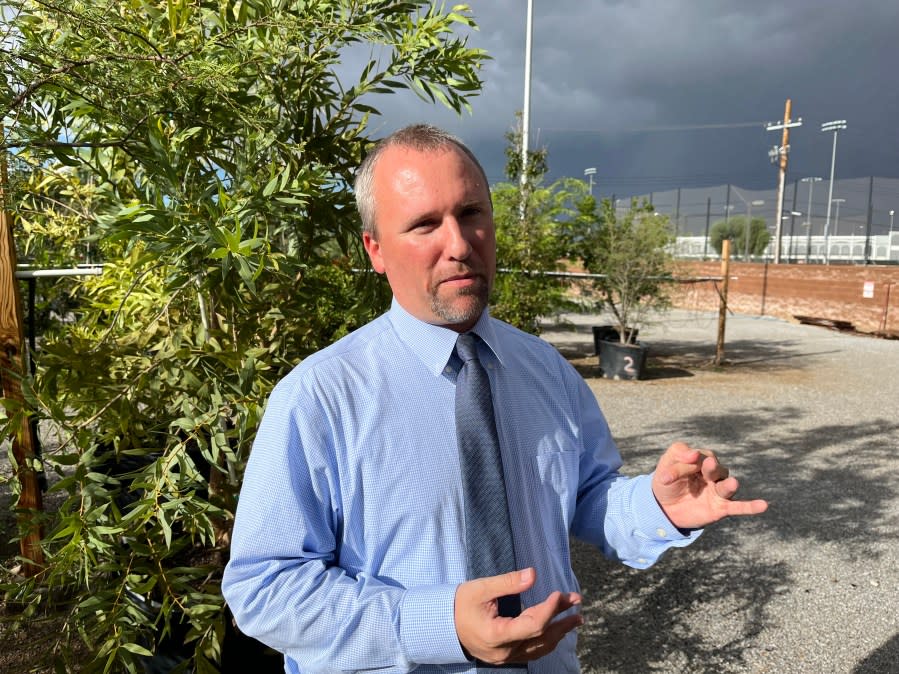A tree for your front yard: Federal grant pays for $5 million Las Vegas planting program
LAS VEGAS (KLAS) — Planting a tree might seem like a small gesture, but the sheer scale of a $1.5 billion effort nationwide will reach all the way to Las Vegas and help to green up some older neighborhoods.
Nearly $15 million in federal grant money is coming to Nevada. Here’s where the money is going:
$5 million: City of Las Vegas
$5 million: UNLV’s Urban Forest Center for Clark County
$3 million: ImpactNV
$1 million: North Las Vegas
$1 million: Soulful Seeds Urban Orchard Project
$500,000: City of Reno
$247,136: Zion United Methodist Church’s urban forest program
The money is coming through the U.S. Forest Service from the Biden administration’s Inflation Reduction Act, and it comes with goals of investing in disadvantaged and underserved communities.
City of Las Vegas program
Marco Velotta from the Las Vegas Office of Sustainability said the $5 million grant will fund a “tree-bate” program that will plant trees in the front yards of east Las Vegas homes.
8 News Now talked to Velotta on Wednesday at one of the city’s maintenance yards at Bonanza Road and Mojave Road, just south of Freedom Park. A corner of that site looks like a tree nursery, with some of the same kinds of trees the city will be placing in nearby neighborhoods.

Velotta called the area around Eastern Avenue and Bonanza Road “ground zero” for programs like this, where aging neighborhoods need an investment. The Charleston Boulevard corridor extending west to Rainbow Boulevard will be another area of focus, he said.
One of the partners in the Las Vegas program, Lisa Ortega of Nevada Plants, described some of the important benefits the program will bring.
“Trees can improve lives by giving us shade and cooling Nevada cities. They are the only thing in the valley that cleans the air by holding dust and sucking carbon from the atmosphere,” she said. “They reduce our power bills and make sure kids can play outside. They shade our bus walks and grace our communities with an aesthetic value for our minds and home values.”
Ortega’s organization will be working in the ZIP codes 89101, 89104 and 89101, providing labor and know-how to get the work done.
Drought tolerant
The city will use trees that thrive in a desert climate — drought-tolerant with big canopies:
Chilean mesquite
Pistache
Desert willow
Holly oak
Mastic
Mulga acacia
Palo verde
Shoestring acacia
Southern live oak
Sweet acacia
Willow acacia
Velotta said these won’t be little sticks — the goal is to use trees in 24-inch boxes as the program gets started.
“We’re going to get as many as we can through the nurseries and try to do things locally,” he said. With this nationwide effort, demand could become an issue and some trees may come from out of state.
Drought-tolerant trees could be next water-saving decision in Las Vegas
And there’s more to it than dropping the tree into a hole. The city plans to educate residents on how to properly care for their new tree — no crowning or topping that can cause damage. And irrigation will be put in place if it’s not already available. Velotta said the city would work with SNWA and Nevada Plants on that front.
The city has been at this for awhile already, with goals established when the 2050 master plan was adopted two years ago.
“We have since planted about 2,000 trees — so, about 1,000 a year — but we’re trying to step up our effort because the overall goal is over the next 30 years we plant 60,000 throughout the entire city itself as well as increase the canopy coverage from where its at now, like 10% on average, up to about 20% by 2050,” Velotta said.
Heat island
Maybe you’ve heard about the “urban heat island” effect. Years of growth have created cities with pavement and parking lots — and fewer green spaces. This program is meant to combat that effect.
A 2020 UNLV study found Las Vegas was “the most intense urban heat island in the United States in both daytime and nighttime metrics between 2004 and 2013.” The study cited temperatures that were 24 degrees higher in the city than in nearby areas. A newer study released in 2023 by the Heat Island Group at Lawrence Berkeley National Laboratory reinforced some of those findings.
Another study — the Southern Nevada Urban Heat Mapping Project — shows not only the areas where the heat island effect is obvious, but also the success of HOA tree planting requirements in areas like Summerlin and Henderson.
“A tree on the west or south side of a home is extremely beneficial,” Ortega said. “Just because you may not live in the ‘deep red’ of the urban heat island, the wind blows and then the heat is somewhere else. We are in this together, so planting trees and caring for trees in peril helps us all.”
Ortega said it’s important to remove large dead trees, too. “There’s lots of beetles out there, and when trees get stressed they become susceptible to the beetles. If you have a large tree, manage it so that you are not harboring or spreading more insects in your residential area,” she said.
For the latest news, weather, sports, and streaming video, head to KLAS.

